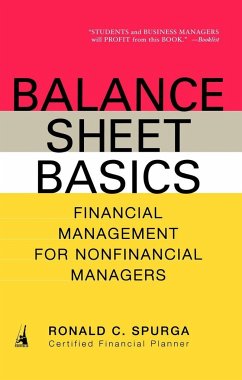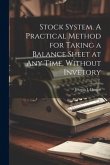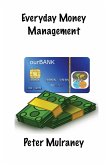20,99 €
inkl. MwSt.
Versandfertig in über 4 Wochen

10 °P sammeln
- Broschiertes Buch
- Merkliste
- Auf die Merkliste
- Bewerten Bewerten
- Teilen
- Produkt teilen
- Produkterinnerung
- Produkterinnerung
Avoiding technical jargon, this user-friendly guide takes the non-financial manager step-by-step through the balance sheet to explain what each number means, while providing clues for good financial management.
The balance sheet is the most basic tool of financial management, yet to most of today's nonfinancial managers it is a complete mystery. In Balance Sheet Basics, Ronald Spurga takes you step by step through the balance sheet to explain not only the line items and what they mean, but also how to interpret ratios derived form the balance sheet, providing an indispensable road map to…mehr
Andere Kunden interessierten sich auch für
![How to Understand the Balance Sheet & Other Periodical Statements How to Understand the Balance Sheet & Other Periodical Statements]() Chartered AccountantHow to Understand the Balance Sheet & Other Periodical Statements18,99 €
Chartered AccountantHow to Understand the Balance Sheet & Other Periodical Statements18,99 €![Net Worth and the Balance Sheet Net Worth and the Balance Sheet]() Herbert Grant StockwellNet Worth and the Balance Sheet20,99 €
Herbert Grant StockwellNet Worth and the Balance Sheet20,99 €![Stock System. A Practical Method for Taking a Balance Sheet at any Time, Without Invetory Stock System. A Practical Method for Taking a Balance Sheet at any Time, Without Invetory]() Joseph L. DuqueStock System. A Practical Method for Taking a Balance Sheet at any Time, Without Invetory14,99 €
Joseph L. DuqueStock System. A Practical Method for Taking a Balance Sheet at any Time, Without Invetory14,99 €![Personal Finances, Personal Freedom Personal Finances, Personal Freedom]() Chanty WebbPersonal Finances, Personal Freedom14,99 €
Chanty WebbPersonal Finances, Personal Freedom14,99 €![I Didn't Know I Could Do That I Didn't Know I Could Do That]() Tony PerroneI Didn't Know I Could Do That25,99 €
Tony PerroneI Didn't Know I Could Do That25,99 €![Everyday Money Management Everyday Money Management]() Peter MulraneyEveryday Money Management11,99 €
Peter MulraneyEveryday Money Management11,99 €![The Freedman's Handbook The Freedman's Handbook]() Wilfred BrownThe Freedman's Handbook11,99 €
Wilfred BrownThe Freedman's Handbook11,99 €-
-
-
Avoiding technical jargon, this user-friendly guide takes the non-financial manager step-by-step through the balance sheet to explain what each number means, while providing clues for good financial management.
The balance sheet is the most basic tool of financial management, yet to most of today's nonfinancial managers it is a complete mystery. In Balance Sheet Basics, Ronald Spurga takes you step by step through the balance sheet to explain not only the line items and what they mean, but also how to interpret ratios derived form the balance sheet, providing an indispensable road map to good financial management. More importantly, you'll find page after page of information that will show you how to improve your 401(k), invest successfully, and increase your net worth.
Hinweis: Dieser Artikel kann nur an eine deutsche Lieferadresse ausgeliefert werden.
The balance sheet is the most basic tool of financial management, yet to most of today's nonfinancial managers it is a complete mystery. In Balance Sheet Basics, Ronald Spurga takes you step by step through the balance sheet to explain not only the line items and what they mean, but also how to interpret ratios derived form the balance sheet, providing an indispensable road map to good financial management. More importantly, you'll find page after page of information that will show you how to improve your 401(k), invest successfully, and increase your net worth.
Hinweis: Dieser Artikel kann nur an eine deutsche Lieferadresse ausgeliefert werden.
Produktdetails
- Produktdetails
- Verlag: Penguin Random House LLC
- Seitenzahl: 176
- Erscheinungstermin: 27. Juli 2004
- Englisch
- Abmessung: 199mm x 129mm x 14mm
- Gewicht: 142g
- ISBN-13: 9781591840527
- ISBN-10: 159184052X
- Artikelnr.: 28432373
- Herstellerkennzeichnung
- Libri GmbH
- Europaallee 1
- 36244 Bad Hersfeld
- gpsr@libri.de
- Verlag: Penguin Random House LLC
- Seitenzahl: 176
- Erscheinungstermin: 27. Juli 2004
- Englisch
- Abmessung: 199mm x 129mm x 14mm
- Gewicht: 142g
- ISBN-13: 9781591840527
- ISBN-10: 159184052X
- Artikelnr.: 28432373
- Herstellerkennzeichnung
- Libri GmbH
- Europaallee 1
- 36244 Bad Hersfeld
- gpsr@libri.de
Ronald C. Spurga, CFP, has worked as an investment banker and Wall Street analyst for several decades. He received his graduate degree from Dartmouth College and taught at Rutgers University, Fordham University, and New York University.
Balance Sheet BasicsPreface
1. What is Financial Management?
Getting the Financial Resources You Need
Making a Profit-Your Basic Obligation
Managing Assets
The Tools of Financial Management
Accounting records
Financial reports
Techniques for analyzing financial statements
2. Financial Statements
The Balance Sheet
Assets
Current assets
Fixed Assets
"Other" Assets
Liabilities
Equity
Valuation accounts
Accounts recievable
Losses in the value of inventions
Fixed assets
Some Examples
The Profit-and-Loss Statement: A Retailer of Wholesaler
Sales
Cost of goods sold
Selling Expenses
General and administrative expenses
Nonoperating income
Profit-and-Loss Statement of a Small Manufacturer
Raw materials
Direct labor
Manufacturing overhead
Interpreting the Profit-and-Loss Statement
Use With Caution!
3. Ratio Analysis of Financial Statements
Businesses are not exactly comparable
Ratios are computed for specific dates
Financial statements show what has happened in the past
The ratios are not ends in themselves
Measure of Liguidity
The current ratio
Working capital
The acid-test ratio
Average collection period
Inventory turnover
Measures of Profitablity
Asset earning power
Return on the owner's equity
Net profit on sales
Investment turnover
Return on investment (ROI)
Common-size Financial Statements
Using the Ratios
4. Control in Business Managemen
Success or Failure Relates to How Management Manages
Those Who Succeed
Business Ratios and How They Work
Statements Reveal Important Relationships
Three Kinds of Ratios
Ten Key Ratios
1. Current assets to current liabilities
2. Current liabilities to tangible net worth
3. Net sales to tangible net worth
4. Net sales to working capital
5. Net profits to tangible net worth
6. Average collection period of receivables
7. Net sales to inventory
8. Fixed assets to tangible net worth
9. Total debt to tangible net worth
10. Net profit on net sales
Analyzing the Profit-and-Loss (Income)
Statement
Net sales
Cost of goods sold
Gross profit on sales
Selling expenses
Operating profit
General and administrative expenses
Financial expenses
Other operating expenses and income
Extraordinary charges (if any)
Net profit before taxes
Taxes
Net profit after taxes
6. Standard or Typical Ratios
Need for Measurements
Growth of Standard Ratio Studies
Sampling the Field
Obtaining the Figures
Assembling the Results
Operating Ratios vs. Financial Ratios
7. Ratio Analysis in Action: A Case History
8. Evaluating and Interpreting Ratios
The Point of View
Interpreting Operating Ratios
Cost of Goods Sold and Gross Margin
Operating Expenses
Wages and salaries
Owner's compensation
Advertising cost
Occupancy cost
Bad debt costs
Interpreting Balance-Sheet Ratios
Current Assets to Current Liabilities
Liabilities to Tangible Net Worth
Turnover of Tangible Net Worth and Working Capital
Net Profits on Tangible Net Worth
Average Collection Period
Inventory Turnover
Fixed Assets to Tangible Net Worth
Management Judgement Necessary
9. Looking Ahead
The Cash Budget
How to do it
The cash balance-how much is enough?
If you need funds-what kind?
Projected Financial Statements
The projected profit-and-loss statement
The projected balance sheet
The cash figure
the receivables and inventory accounts
Fixed assets
Accrued liabilities and long-term debts
The accounts payable figure
The equity account
Points to Remember
Looking Still Further Ahead
10. The Different Types of Financing
Equity Capital
Working Capital
Growth Capital
SBA Loans
SBICs and Other Venture Capital Sources
When to Turn to Venture Capitalists
11. Unsecured Borrowings for Working Capital
"The Annual Clean-Up"
Putting Your Best Foot Forward
12. Secured Working Capital Financing
Accounts Receivable Financing
Factoring
13. Secured Growth Capital Financing
Leasing
Conditional Sales Purchases
Sale Leasebacks
Pulling the Various Elements Together
14. For Further Information
Sources of Industry Ratio Data
U.S. Government Publications
Books
Appendix
Index
1. What is Financial Management?
Getting the Financial Resources You Need
Making a Profit-Your Basic Obligation
Managing Assets
The Tools of Financial Management
Accounting records
Financial reports
Techniques for analyzing financial statements
2. Financial Statements
The Balance Sheet
Assets
Current assets
Fixed Assets
"Other" Assets
Liabilities
Equity
Valuation accounts
Accounts recievable
Losses in the value of inventions
Fixed assets
Some Examples
The Profit-and-Loss Statement: A Retailer of Wholesaler
Sales
Cost of goods sold
Selling Expenses
General and administrative expenses
Nonoperating income
Profit-and-Loss Statement of a Small Manufacturer
Raw materials
Direct labor
Manufacturing overhead
Interpreting the Profit-and-Loss Statement
Use With Caution!
3. Ratio Analysis of Financial Statements
Businesses are not exactly comparable
Ratios are computed for specific dates
Financial statements show what has happened in the past
The ratios are not ends in themselves
Measure of Liguidity
The current ratio
Working capital
The acid-test ratio
Average collection period
Inventory turnover
Measures of Profitablity
Asset earning power
Return on the owner's equity
Net profit on sales
Investment turnover
Return on investment (ROI)
Common-size Financial Statements
Using the Ratios
4. Control in Business Managemen
Success or Failure Relates to How Management Manages
Those Who Succeed
Business Ratios and How They Work
Statements Reveal Important Relationships
Three Kinds of Ratios
Ten Key Ratios
1. Current assets to current liabilities
2. Current liabilities to tangible net worth
3. Net sales to tangible net worth
4. Net sales to working capital
5. Net profits to tangible net worth
6. Average collection period of receivables
7. Net sales to inventory
8. Fixed assets to tangible net worth
9. Total debt to tangible net worth
10. Net profit on net sales
Analyzing the Profit-and-Loss (Income)
Statement
Net sales
Cost of goods sold
Gross profit on sales
Selling expenses
Operating profit
General and administrative expenses
Financial expenses
Other operating expenses and income
Extraordinary charges (if any)
Net profit before taxes
Taxes
Net profit after taxes
6. Standard or Typical Ratios
Need for Measurements
Growth of Standard Ratio Studies
Sampling the Field
Obtaining the Figures
Assembling the Results
Operating Ratios vs. Financial Ratios
7. Ratio Analysis in Action: A Case History
8. Evaluating and Interpreting Ratios
The Point of View
Interpreting Operating Ratios
Cost of Goods Sold and Gross Margin
Operating Expenses
Wages and salaries
Owner's compensation
Advertising cost
Occupancy cost
Bad debt costs
Interpreting Balance-Sheet Ratios
Current Assets to Current Liabilities
Liabilities to Tangible Net Worth
Turnover of Tangible Net Worth and Working Capital
Net Profits on Tangible Net Worth
Average Collection Period
Inventory Turnover
Fixed Assets to Tangible Net Worth
Management Judgement Necessary
9. Looking Ahead
The Cash Budget
How to do it
The cash balance-how much is enough?
If you need funds-what kind?
Projected Financial Statements
The projected profit-and-loss statement
The projected balance sheet
The cash figure
the receivables and inventory accounts
Fixed assets
Accrued liabilities and long-term debts
The accounts payable figure
The equity account
Points to Remember
Looking Still Further Ahead
10. The Different Types of Financing
Equity Capital
Working Capital
Growth Capital
SBA Loans
SBICs and Other Venture Capital Sources
When to Turn to Venture Capitalists
11. Unsecured Borrowings for Working Capital
"The Annual Clean-Up"
Putting Your Best Foot Forward
12. Secured Working Capital Financing
Accounts Receivable Financing
Factoring
13. Secured Growth Capital Financing
Leasing
Conditional Sales Purchases
Sale Leasebacks
Pulling the Various Elements Together
14. For Further Information
Sources of Industry Ratio Data
U.S. Government Publications
Books
Appendix
Index
Balance Sheet BasicsPreface
1. What is Financial Management?
Getting the Financial Resources You Need
Making a Profit-Your Basic Obligation
Managing Assets
The Tools of Financial Management
Accounting records
Financial reports
Techniques for analyzing financial statements
2. Financial Statements
The Balance Sheet
Assets
Current assets
Fixed Assets
"Other" Assets
Liabilities
Equity
Valuation accounts
Accounts recievable
Losses in the value of inventions
Fixed assets
Some Examples
The Profit-and-Loss Statement: A Retailer of Wholesaler
Sales
Cost of goods sold
Selling Expenses
General and administrative expenses
Nonoperating income
Profit-and-Loss Statement of a Small Manufacturer
Raw materials
Direct labor
Manufacturing overhead
Interpreting the Profit-and-Loss Statement
Use With Caution!
3. Ratio Analysis of Financial Statements
Businesses are not exactly comparable
Ratios are computed for specific dates
Financial statements show what has happened in the past
The ratios are not ends in themselves
Measure of Liguidity
The current ratio
Working capital
The acid-test ratio
Average collection period
Inventory turnover
Measures of Profitablity
Asset earning power
Return on the owner's equity
Net profit on sales
Investment turnover
Return on investment (ROI)
Common-size Financial Statements
Using the Ratios
4. Control in Business Managemen
Success or Failure Relates to How Management Manages
Those Who Succeed
Business Ratios and How They Work
Statements Reveal Important Relationships
Three Kinds of Ratios
Ten Key Ratios
1. Current assets to current liabilities
2. Current liabilities to tangible net worth
3. Net sales to tangible net worth
4. Net sales to working capital
5. Net profits to tangible net worth
6. Average collection period of receivables
7. Net sales to inventory
8. Fixed assets to tangible net worth
9. Total debt to tangible net worth
10. Net profit on net sales
Analyzing the Profit-and-Loss (Income)
Statement
Net sales
Cost of goods sold
Gross profit on sales
Selling expenses
Operating profit
General and administrative expenses
Financial expenses
Other operating expenses and income
Extraordinary charges (if any)
Net profit before taxes
Taxes
Net profit after taxes
6. Standard or Typical Ratios
Need for Measurements
Growth of Standard Ratio Studies
Sampling the Field
Obtaining the Figures
Assembling the Results
Operating Ratios vs. Financial Ratios
7. Ratio Analysis in Action: A Case History
8. Evaluating and Interpreting Ratios
The Point of View
Interpreting Operating Ratios
Cost of Goods Sold and Gross Margin
Operating Expenses
Wages and salaries
Owner's compensation
Advertising cost
Occupancy cost
Bad debt costs
Interpreting Balance-Sheet Ratios
Current Assets to Current Liabilities
Liabilities to Tangible Net Worth
Turnover of Tangible Net Worth and Working Capital
Net Profits on Tangible Net Worth
Average Collection Period
Inventory Turnover
Fixed Assets to Tangible Net Worth
Management Judgement Necessary
9. Looking Ahead
The Cash Budget
How to do it
The cash balance-how much is enough?
If you need funds-what kind?
Projected Financial Statements
The projected profit-and-loss statement
The projected balance sheet
The cash figure
the receivables and inventory accounts
Fixed assets
Accrued liabilities and long-term debts
The accounts payable figure
The equity account
Points to Remember
Looking Still Further Ahead
10. The Different Types of Financing
Equity Capital
Working Capital
Growth Capital
SBA Loans
SBICs and Other Venture Capital Sources
When to Turn to Venture Capitalists
11. Unsecured Borrowings for Working Capital
"The Annual Clean-Up"
Putting Your Best Foot Forward
12. Secured Working Capital Financing
Accounts Receivable Financing
Factoring
13. Secured Growth Capital Financing
Leasing
Conditional Sales Purchases
Sale Leasebacks
Pulling the Various Elements Together
14. For Further Information
Sources of Industry Ratio Data
U.S. Government Publications
Books
Appendix
Index
1. What is Financial Management?
Getting the Financial Resources You Need
Making a Profit-Your Basic Obligation
Managing Assets
The Tools of Financial Management
Accounting records
Financial reports
Techniques for analyzing financial statements
2. Financial Statements
The Balance Sheet
Assets
Current assets
Fixed Assets
"Other" Assets
Liabilities
Equity
Valuation accounts
Accounts recievable
Losses in the value of inventions
Fixed assets
Some Examples
The Profit-and-Loss Statement: A Retailer of Wholesaler
Sales
Cost of goods sold
Selling Expenses
General and administrative expenses
Nonoperating income
Profit-and-Loss Statement of a Small Manufacturer
Raw materials
Direct labor
Manufacturing overhead
Interpreting the Profit-and-Loss Statement
Use With Caution!
3. Ratio Analysis of Financial Statements
Businesses are not exactly comparable
Ratios are computed for specific dates
Financial statements show what has happened in the past
The ratios are not ends in themselves
Measure of Liguidity
The current ratio
Working capital
The acid-test ratio
Average collection period
Inventory turnover
Measures of Profitablity
Asset earning power
Return on the owner's equity
Net profit on sales
Investment turnover
Return on investment (ROI)
Common-size Financial Statements
Using the Ratios
4. Control in Business Managemen
Success or Failure Relates to How Management Manages
Those Who Succeed
Business Ratios and How They Work
Statements Reveal Important Relationships
Three Kinds of Ratios
Ten Key Ratios
1. Current assets to current liabilities
2. Current liabilities to tangible net worth
3. Net sales to tangible net worth
4. Net sales to working capital
5. Net profits to tangible net worth
6. Average collection period of receivables
7. Net sales to inventory
8. Fixed assets to tangible net worth
9. Total debt to tangible net worth
10. Net profit on net sales
Analyzing the Profit-and-Loss (Income)
Statement
Net sales
Cost of goods sold
Gross profit on sales
Selling expenses
Operating profit
General and administrative expenses
Financial expenses
Other operating expenses and income
Extraordinary charges (if any)
Net profit before taxes
Taxes
Net profit after taxes
6. Standard or Typical Ratios
Need for Measurements
Growth of Standard Ratio Studies
Sampling the Field
Obtaining the Figures
Assembling the Results
Operating Ratios vs. Financial Ratios
7. Ratio Analysis in Action: A Case History
8. Evaluating and Interpreting Ratios
The Point of View
Interpreting Operating Ratios
Cost of Goods Sold and Gross Margin
Operating Expenses
Wages and salaries
Owner's compensation
Advertising cost
Occupancy cost
Bad debt costs
Interpreting Balance-Sheet Ratios
Current Assets to Current Liabilities
Liabilities to Tangible Net Worth
Turnover of Tangible Net Worth and Working Capital
Net Profits on Tangible Net Worth
Average Collection Period
Inventory Turnover
Fixed Assets to Tangible Net Worth
Management Judgement Necessary
9. Looking Ahead
The Cash Budget
How to do it
The cash balance-how much is enough?
If you need funds-what kind?
Projected Financial Statements
The projected profit-and-loss statement
The projected balance sheet
The cash figure
the receivables and inventory accounts
Fixed assets
Accrued liabilities and long-term debts
The accounts payable figure
The equity account
Points to Remember
Looking Still Further Ahead
10. The Different Types of Financing
Equity Capital
Working Capital
Growth Capital
SBA Loans
SBICs and Other Venture Capital Sources
When to Turn to Venture Capitalists
11. Unsecured Borrowings for Working Capital
"The Annual Clean-Up"
Putting Your Best Foot Forward
12. Secured Working Capital Financing
Accounts Receivable Financing
Factoring
13. Secured Growth Capital Financing
Leasing
Conditional Sales Purchases
Sale Leasebacks
Pulling the Various Elements Together
14. For Further Information
Sources of Industry Ratio Data
U.S. Government Publications
Books
Appendix
Index







